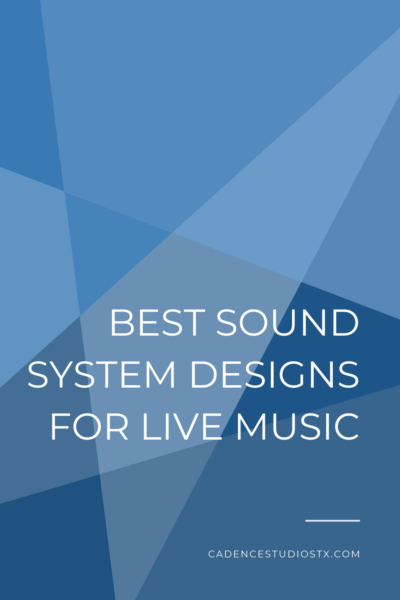Best Sound System Designs For Live Music
Setting up a sound system for a live band no matter the size of the audience is no small task to undertake considering there are a multitude of strategic and technological elements at tech’s disposals. With such a broad range of sound reinforcement equipment and techniques, the choices can easily be overwhelming. Here we will discuss some of your options and what might work best for you in your next live set up!

Speaker Selection
First and foremost, you will want to decide on your speakers by basing your choice on the size of the venue and the coverage requirements your band will need. Of course every event has a budget so you will want to start with figuring out what speakers sound best to you within that price range. Always be sure to listen to a speaker before buying and consult the specification sheet provide by the manufacturer. The important things to know are frequency response, SPL output, and dispersion.
Full-range speakers that have a frequency response of 60 Hz to 18 kHz will work for genres of music where the kick drum and bass will not need an extra punch such as country or folk. For rock, metal, pop, and other heavy bass genres, you will want a subwoofer that extends the frequency response to 45 Hz or lower to allow the full-range speakers additional headroom and increased output ability.
SPL, or sound pressure level, is what measures how load a speaker is. Your audience will want to hear you between 92dB SPL and 98dB SPL as anything lower you will lose the energy of the performance while anything higher might cause discomfort. Many things factor into the final decision on the level, including room size and stage distance between the band and audience, so be sure to check with your audio-visual partner on what they believe will be the best output to use.
Dispersion is the way sound is projected and used to determine the placement of your speakers so you can direct the sound away from the boundaries in the space such as walls and ceilings. Vertical dispersion determines how high the full-range top speakers will need to be to provide coverage for the entire audience. The higher the speaker, the farther the sound will travel. If the speakers are placed too high there will be a loss of sound impact in the front while if it is not high enough it may be uncomfortably loud for the front rows.
Mixers
You’ll have two options when it comes to choosing a mixer for your setup: Analog and Digital
Analog mixers are the mainstay of any audio system, and many analog enthusiasts feel the components sound superior to digital. When mixing a live band, you will want additional signal processors to shape the sound of each instrument and most analog consoles offer a built-in four band parametric equalizer which helps balance the tonal sound and creates space for each instrument in the live mix. However, most analog mixers do not have built-in dynamics available on every channel so using an all-analog setup will require several racks of gear to accommodate the additional signal processing.
Digital mixers have made many advances in recent years with the quality of sound and the pricing is comparable to moderately priced analog consoles. Digital mixers are the best solution for a touring band with their large channel count, multi packing four band equalizers on each channel, and gating, as well graphic equalizers on each output for ringing out monitors. Digital mixers reduce the amount of gear needed substantially and offer wireless control options with many able to use iOS and Android control apps.
Snakes and Boxes
A stage box or stage snake is beneficial for reducing all the clutter on stage. When working with an analog setup you are working with a 16-24 channel audio snake and at least 100 feet of cable. In fact, your drum kit alone could have up to 12 microphones to capture the sound, so a dedicated snake allows for shorter mic cables to give a much cleaner and less busy stage setup. Digital mixers use digital stage boxes that function like the stage snakes for analog systems only instead of a multi-channel cable, digital snakes use a single CAT5 cable to connect the mixer to the front of house position. This will cut down on the weight, clutter, and setup time of the entire system.
Microphones and In-Ear Monitors
Live music uses dynamic microphones which are mics that convert sound into an electrical signal by using electromagnetism. While you’ll find many manufacturers of these type of mics, most clubs favor the Shure SM58 for vocals and SM57 for instrumental.
Many bands prefer to use in-ear monitors, or IEMs, over stage monitors. In-ear monitors block out the sound of the amplified instruments and acoustic elements such as drums and allows you to have the mix at a lower level and protect your ears as well as have a clearer sound of the individual’s sound. With a digital mixer the setup and operation are simple, and musicians are happy to be able to set up their own monitor mix without excessive stage volume.
There are many choices when it comes to setting up a sound system for your band and each has its pluses and negatives. Using your ears and being sure to listen before you make a final decision is the most important thing to do when going through options with your audio-visual team.




